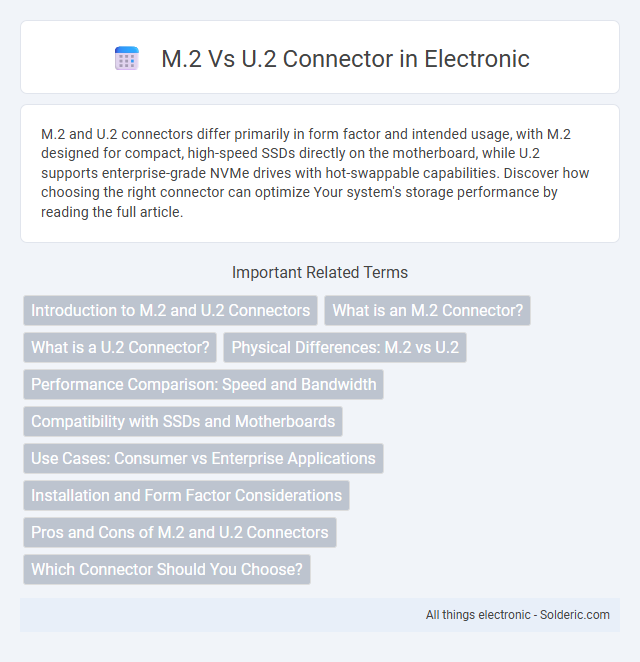M.2 and U.2 connectors differ primarily in form factor and intended usage, with M.2 designed for compact, high-speed SSDs directly on the motherboard, while U.2 supports enterprise-grade NVMe drives with hot-swappable capabilities. Discover how choosing the right connector can optimize Your system's storage performance by reading the full article.
Comparison Table
| Feature | M.2 Connector | U.2 Connector |
|---|---|---|
| Form Factor | Compact, card-like (up to 110mm length) | 2.5-inch drive bay format |
| Interface | PCIe NVMe, SATA (via M.2 slot) | PCIe NVMe, SATA (via SFF-8639 connector) |
| Connector Type | Edge connector with 75 pins | SFF-8639 68-pin connector |
| Performance | Up to PCIe 4.0 x4 (~7,000 MB/s) | Up to PCIe 4.0 x4 (~7,000 MB/s) |
| Power Delivery | 3.3V, limited power (~7-15W) | 3.3V and 12V, higher power delivery (up to 25W) |
| Cooling | Limited passive cooling, prone to thermal throttling | Better cooling potential using drive bays and heat sinks |
| Use Case | Laptops, desktops, compact builds | Enterprise storage, servers, high-performance desktops |
| Installation | Direct motherboard slot installation | Connected via cable to drive bay and motherboard |
Introduction to M.2 and U.2 Connectors
M.2 and U.2 connectors serve as interfaces for high-speed storage devices, with M.2 primarily designed for compact SSDs used in laptops and desktops, offering PCIe and SATA support. U.2 connectors cater to enterprise-level NVMe SSDs, providing robust hot-swappable capabilities and higher power delivery for 2.5-inch drives. Both standards facilitate faster data transfer rates compared to traditional SATA connections, optimizing performance in modern computing environments.
What is an M.2 Connector?
An M.2 connector is a compact interface designed for high-speed storage devices like NVMe SSDs, commonly used in modern laptops and desktops due to its small size and direct PCIe bus connection. It supports various protocols, including SATA and PCIe, enabling faster data transfer rates compared to traditional SATA connectors. M.2 slots come in different keying types, such as M-key and B-key, to accommodate varying device functionalities and compatibility.
What is a U.2 Connector?
A U.2 connector is a high-performance interface designed for connecting solid-state drives (SSDs) directly to a computer's PCIe bus, enabling faster data transfer speeds than traditional SATA connections. It supports NVMe protocol and is commonly used in enterprise-level storage solutions due to its reliable power delivery and enhanced thermal management. Unlike the smaller M.2 connector, U.2 connectors are larger and use a cable-based connection, allowing for easier installation and better airflow within server chassis.
Physical Differences: M.2 vs U.2
M.2 connectors are compact, typically measuring 22mm wide and varying lengths, designed for direct motherboard installation with a keying notch to prevent improper insertion. U.2 connectors, formerly known as SFF-8639, are larger, resembling traditional 2.5-inch drive interfaces with a robust latch mechanism to secure the cable connection. The physical distinction highlights M.2's slot-based form factor optimized for space-saving on desktops and laptops, while U.2 is tailored for enterprise storage environments requiring high durability and hot-swapping capabilities.
Performance Comparison: Speed and Bandwidth
M.2 connectors support PCIe NVMe SSDs with speeds up to 7,000 MB/s using PCIe 4.0 x4 lanes, providing high bandwidth in compact form factors ideal for laptops and desktops. U.2 connectors leverage the same PCIe lanes but typically offer better thermal management and power delivery, enabling sustained high-speed data transfer around 3,500 MB/s with PCIe 3.0, often preferred in enterprise storage due to reliability. Your choice between M.2 and U.2 impacts performance depending on whether maximum speed or enhanced endurance under heavy workloads is prioritized.
Compatibility with SSDs and Motherboards
M.2 connectors support a wide range of SSDs, including SATA and NVMe protocols, making them compatible with most modern motherboards featuring M.2 slots. U.2 connectors are designed primarily for high-performance NVMe SSDs and require motherboards equipped with dedicated U.2 ports or adapters. While M.2 drives are more common in consumer desktops and laptops, U.2 connectors are favored in enterprise systems due to their robust design and support for higher endurance SSDs.
Use Cases: Consumer vs Enterprise Applications
M.2 connectors are primarily designed for consumer applications such as laptops, desktops, and gaming systems due to their compact size and ease of integration with PCIe SSDs. U.2 connectors are favored in enterprise environments for high-performance storage solutions, offering hot-swappable capabilities and enhanced durability suited for data centers and servers. Your choice between M.2 and U.2 depends on whether you prioritize compact consumer devices or robust, scalable enterprise storage infrastructure.
Installation and Form Factor Considerations
M.2 connectors offer compact, key-specific designs ideal for laptops and small form factor PCs, making installation straightforward with screw mounting on a motherboard standoff. U.2 connectors utilize a larger, cable-based interface suited for enterprise-grade SSDs, requiring dedicated ports and more internal space for airflow and connectivity. Your choice depends on device compatibility and the balance between ease of installation and desired performance in various form factor environments.
Pros and Cons of M.2 and U.2 Connectors
M.2 connectors offer compact size and high-speed NVMe SSD compatibility, making them ideal for laptops and desktops with limited space, but their thermal management can be challenging and they typically support shorter cable lengths. U.2 connectors provide better cooling options and robust performance, supporting enterprise-grade NVMe SSDs with excellent scalability and longer cable lengths, though they require more physical space and higher motherboard compatibility. Your choice depends on balancing space constraints, thermal considerations, and the need for performance scalability in storage solutions.
Which Connector Should You Choose?
Choosing between M.2 and U.2 connectors depends on your device's compatibility and performance needs. M.2 is ideal for compact builds and laptops, offering high-speed NVMe SSDs with a small form factor. You should opt for U.2 if your system supports it and you require enterprise-level storage with easier drive swapping and higher thermal capacity.
M.2 vs U.2 connector Infographic

 solderic.com
solderic.com